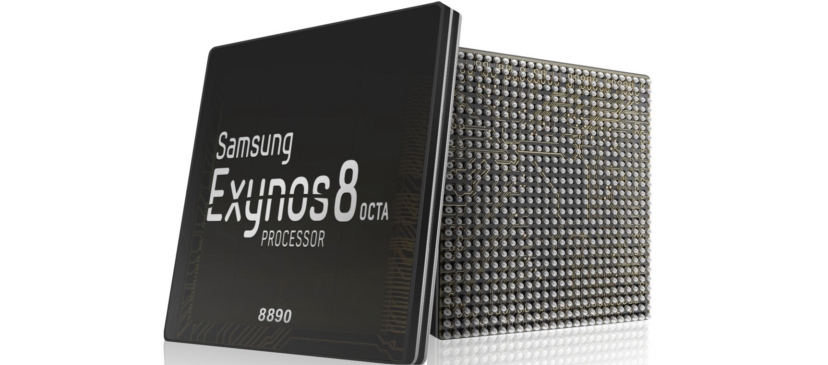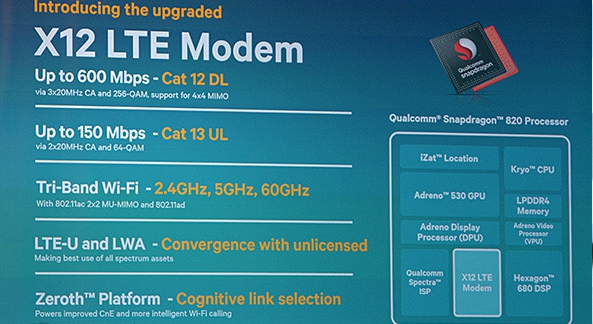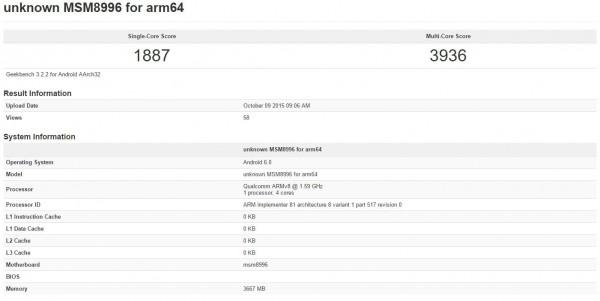
Samsung Semiconductor today announced the Exynos 8890 eight-core processor in South Korea. This is Samsung's second SoC based on 14nm FinFET process. Unlike the Exynos 7420, the Exynos 8890 is a true full-chip solution that integrates a CPU/GPU/ISP and the latest LTE Cat. 12/13 baseband. Samsung's first 64-bit ARMv8 architecture CPU is used, which is the previously rumored Mongoose framework.

The CPU part is composed of 4 core cats + 4 cores A53, which strengthens multi-core scheduling capabilities, enhances multitasking/process performance, and can better improve the utilization efficiency of 8 cores.
Although the Samsung GPU did not mention it, the Mali-T880 MP12 was extremely aggressive and had 12 graphics cores. It struck the Unicorn 950 Mali-T880 MP4. The official claims this is to prepare for immersive 3D games and virtual reality experiences.

The picture shows the X12 LTE baseband equipped with the Qualcomm Snapdragon 820
Baseband also caught up with the baseband maddened Qualcomm, down Cat.12, the maximum download speed up to 600Mbps; Upstream Cat.13, the maximum upload speed up to 150Mbps (has been flat with the domestic 4G download speed ...) and Xiaolong 820 flat . Samsung said that Exynos 8890 plans to begin mass production at the end of 2015.

The official announced that the Exynos 8890 had a 30% improvement in performance over the 7420, with a 10% increase in performance. Note that the official text is power efficiency rather than power consumption. Considering the improvement of performance, the actual power consumption of the CPU part should be higher than 7420.
In line with the previous Geekbench run score on the Internet, the Exynos 8890 (Exynos M1) scored 2294 with a single-threaded score of 2.3 GHz and a multi-threaded score of 6908. Compared with the Apple A9, the single thread is 1.1 times weaker and the multi thread is 1.57 times stronger. Maintained the weak single-core and multi-core status of the previous Android platform.
However, the GPU portion of the upgrade is even greater. Compared to the 7420 Mali-T760 MP8, the GPU architecture has been upgraded with four more cores. Even if Samsung let it run low frequencies, this performance is also very impressive. But the author is more concerned about how Samsung controls its power consumption, even if the process is slightly improved and run low frequency, a full 50% of the core, once the power consumption and heating are estimated to be very exaggerated.
CPU and GPU power consumption are likely to increase, plus Samsung's baseband this time a big leap forward, power consumption may be difficult to control, the three are mixed together, so that I can not help but worry about its fever and power consumption.

Geekbench running points of the Kirin 950

Geekbench running points for Xiaolong 820
Judging from the information leaked now, Exynos 8890 is compared with Qualcomm 820/Kylin 950 in the same generation. CPU section:
Exynos 8890 took a single-core close to 2300, and the multi-core close to 7000 had a temporary lead;
The Unicorn 950 single-core 1700, about 6300 multi-core;
The Snapdragon 820 is a single-core 1900, with about 4000 points of multi-core.
GPU section:
The strongest of the previous generation Android platform was the Qualcomm Adreno 430, while the Adreno 530 on the 820 announced a 40% increase over the previous generation.
Samsung and Unicorn are Mali-T880, but the Unicorn 950 is a Mali-T880MP4. The number of cores is much less than Samsung's violent Mali-T880MP12, and its performance is not very good.
The frequency of Samsung's T880MP12 is unknown. If it can maintain the frequency of previous generations' closeness, 50% increase in the number of cores and upgrade of the architecture will definitely bring about more than 50% improvement. It can compete with Adreno 530 and may even be able to win. .
Regardless of the power consumption problem that cannot be judged right now, Samsung's SoC is likely to continue Android's strongest name, and this generation also brought the strongest baseband with Qualcomm's. However, like this year's Samsung Shannon baseband, Exynos 8890 baseband estimates do not support telecom CDMA networks...
The noteworthy details are that Exynos 8890 announced production time at the end of this year. Qualcomm 820 and Kirin 950, which were released several days earlier than Exynos 8890, did not seem to mention their production time. The next year's S7 may be as rumors say, will be released in advance in February-March.
In the case of Snapdragon 820, no vendor has rushed to grab its starting lineup. However, there were rumors yesterday that the Samsung S7's SoC would be split between 820 and Exynos 8890. The production time of the Nine Dragon 820 should not be too much behind Exynos 8890.
Kirin 950 is likely to be launched by Mella8, which was rumored to be released on November 26th. Kirin 950 will be the earliest to come out, but if Huawei learns millet's PPT starting habits, the machine equipped with the Kirin 950 may have to wait until early 2016.

![<?echo $_SERVER['SERVER_NAME'];?>](/template/twentyseventeen/skin/images/header.jpg)